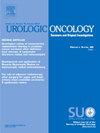基于瘤内生境成像的临床放射组学模型的开发与验证,用于预测透明细胞肾细胞癌患者的无进展生存期:一项多中心研究。
IF 2.4
3区 医学
Q3 ONCOLOGY
Urologic Oncology-seminars and Original Investigations
Pub Date : 2024-10-05
DOI:10.1016/j.urolonc.2024.09.025
引用次数: 0
摘要
目的:开发并验证基于瘤内生境成像的临床放射组学模型,用于术前预测透明细胞肾细胞癌(ccRCC)的无进展生存期(PFS),并分析与进展相关的基因表达:这项回顾性研究纳入了多中心数据库中的691名ccRCC患者。根据像素级灰度共现矩阵分析,用手工制作的流程对整个肿瘤进行分割,生成栖息地亚区。利用传统的容积放射组学特征(Radiomics)、生境子区域衍生放射组学(Rad-Habitat)以及生境放射组学与临床特征的整合(Hybrid Cox)构建了预测PFS的Cox回归模型。在南京队列中进行了训练(n = 393)和内部验证(n = 118),在武汉和浙江队列(n = 227)以及具有成像-基因组相关性的TCGA-KIRC(n = 71)中进行了外部验证。统计分析包括ROC曲线下面积分析、C指数、决策曲线分析(DCA)和Kaplan-Meier生存分析:结果:混合 Cox 模型在 PFS 预测方面的内部验证 C 指数为 0.83(95% CI,0.73-0.93),外部验证为 0.79(95% CI,0.74-0.84),高于 Radiomics 和 Rad-Habitat 模型。通过混合 Cox 模型分层的患者在 3 组数据中的高危组和低危组存活率存在显著差异(经 Log-rank 检验,P 均小于 0.001)。TCGA-KIRC数据分析显示,37个上调基因和81个下调基因与ccRCC的生境成像特征相关。差异表达的基因可能在蛋白质和矿物质代谢、免疫防御和细胞极性维持中发挥关键作用。本文章由计算机程序翻译,如有差异,请以英文原文为准。
Development and validation of a clinic-radiomics model based on intratumoral habitat imaging for progression-free survival prediction of patients with clear cell renal cell carcinoma: A multicenter study
Purpose
To develop and validate a clinicoradiomics model based on intratumoral habitat imaging for preoperatively predicting of progression-free survival (PFS) of clear cell renal cell carcinoma (ccRCC) and analyzing progression-associated genes expression.
Methods
This retrospective study included 691 ccRCC patients from multicenter databases. Entire tumor segmentation was performed with handcrafted process to generate habitat subregions based on a pixel-wise gray-level co-occurrence matrix analysis. Cox regression models for PFS prediction were constructed using conventional volumetric radiomics features (Radiomics), habitat subregions-derived radiomics (Rad-Habitat), and an integration of habitat radiomics and clinical characteristics (Hybrid Cox). Training (n = 393) and internal validation (n = 118) was performed in a Nanjing cohort, external validation was performed in a Wuhan and Zhejiang cohort (n = 227) and in a TCGA-KIRC (n =71) with imaging-genomic correlation. Statistical analysis included the area-under-ROC curve analysis, C-index, decision curve analysis (DCA) and Kaplan-Meier survival analysis.
Results
Hybrid Cox model resulted in a C-index of 0.83 (95% CI, 0.73–0.93) in internal validation and 0.79 (95% CI, 0.74–0.84) in external validation for PFS prediction, higher than Radiomics and Rad-Habitat model. Patients stratified by Hybrid Cox model presented with significant difference survivals between high-risk and low-risk group in 3 data sets (all P < 0.001 at Log-rank test). TCGA-KIRC data analysis revealed 37 upregulated and 81 downregulated genes associated with habitat imaging features of ccRCC. Differentially expressed genes likely play critical roles in protein and mineral metabolism, immune defense, and cellular polarity maintenance.
求助全文
通过发布文献求助,成功后即可免费获取论文全文。
去求助
来源期刊
CiteScore
4.80
自引率
3.70%
发文量
297
审稿时长
7.6 weeks
期刊介绍:
Urologic Oncology: Seminars and Original Investigations is the official journal of the Society of Urologic Oncology. The journal publishes practical, timely, and relevant clinical and basic science research articles which address any aspect of urologic oncology. Each issue comprises original research, news and topics, survey articles providing short commentaries on other important articles in the urologic oncology literature, and reviews including an in-depth Seminar examining a specific clinical dilemma. The journal periodically publishes supplement issues devoted to areas of current interest to the urologic oncology community. Articles published are of interest to researchers and the clinicians involved in the practice of urologic oncology including urologists, oncologists, and radiologists.

 求助内容:
求助内容: 应助结果提醒方式:
应助结果提醒方式:


